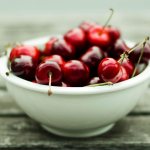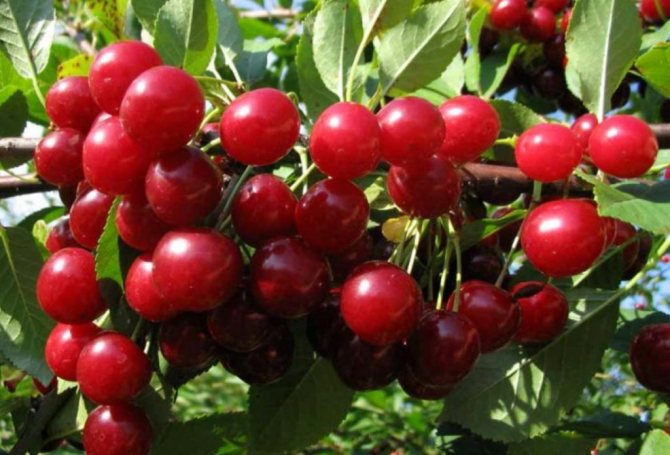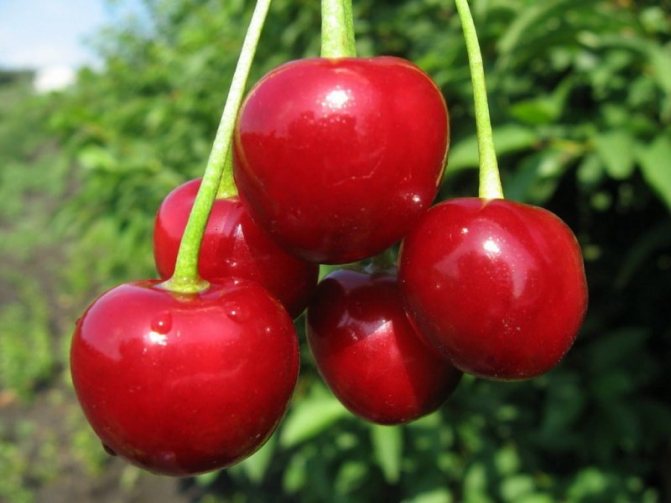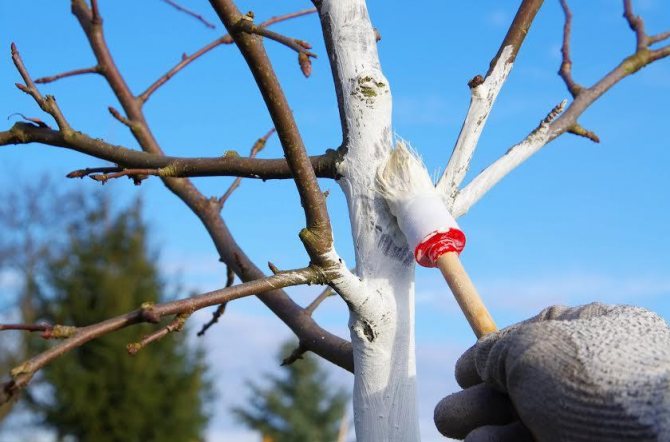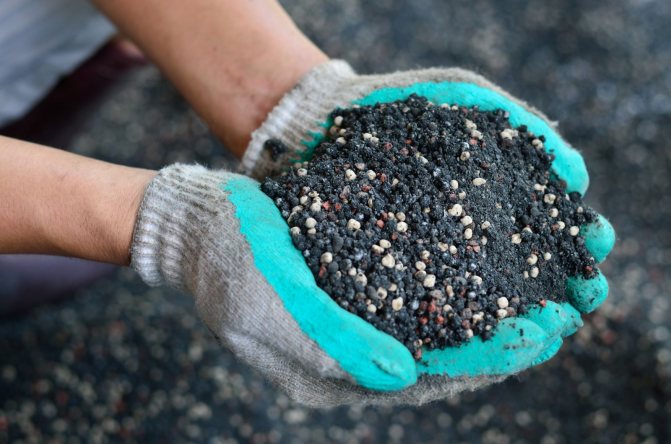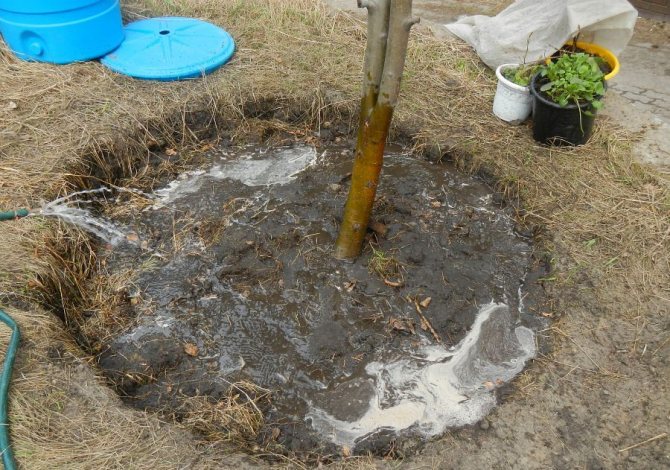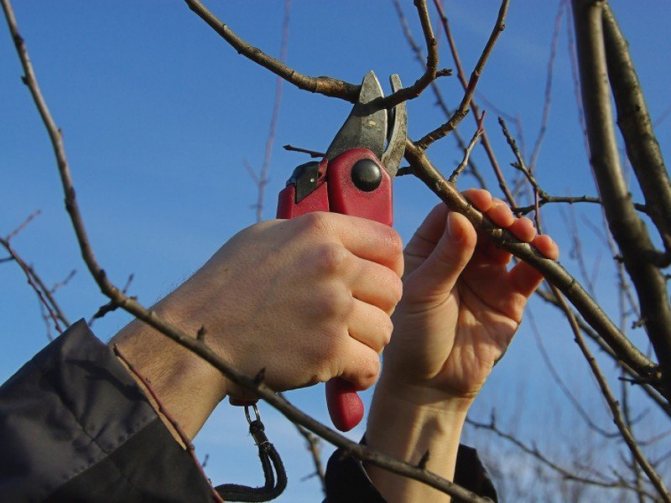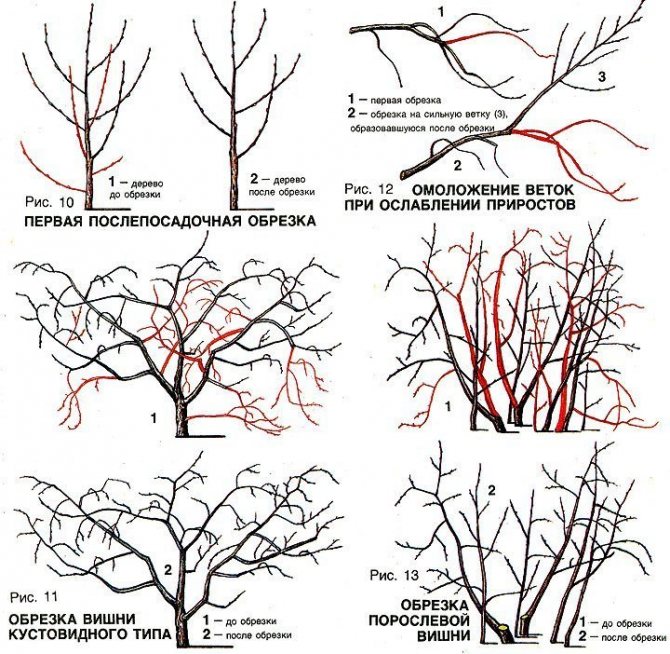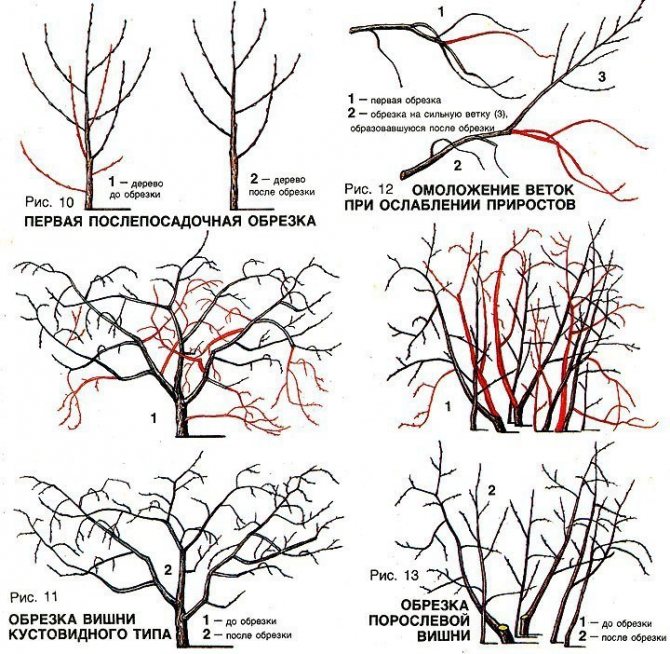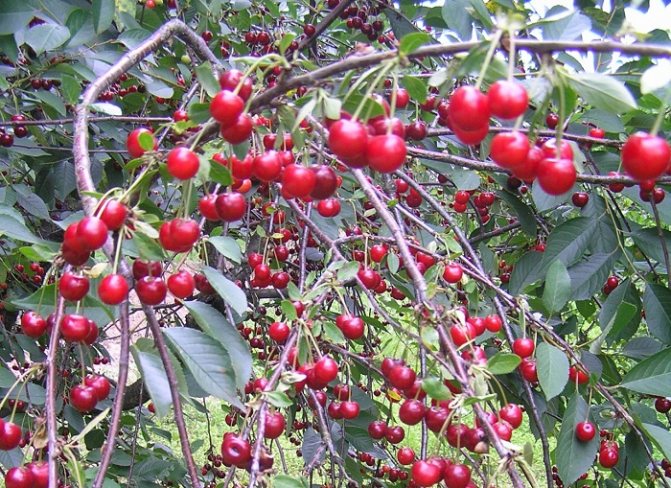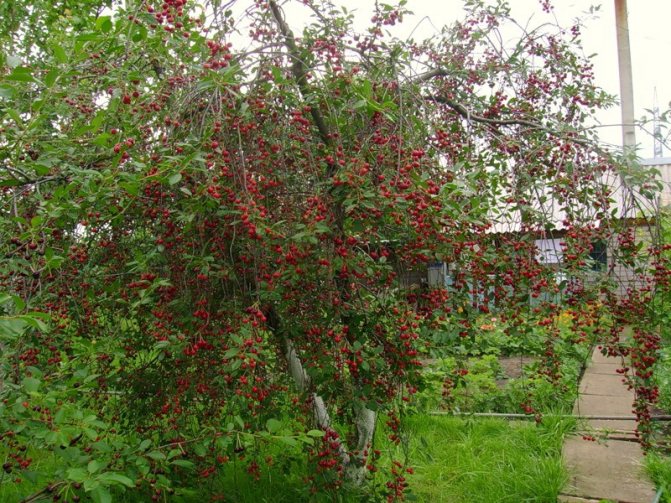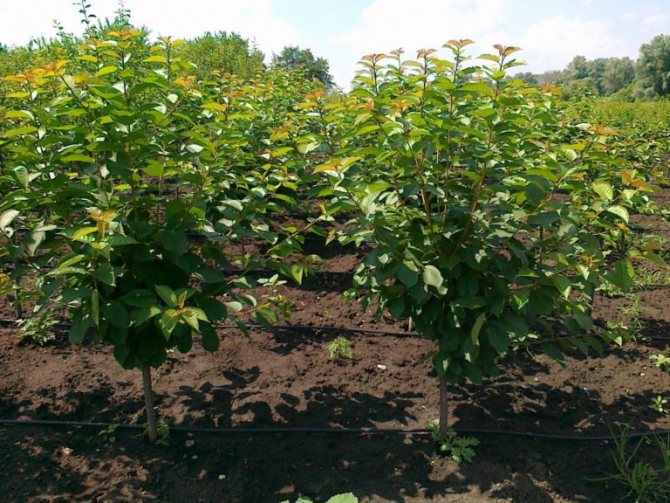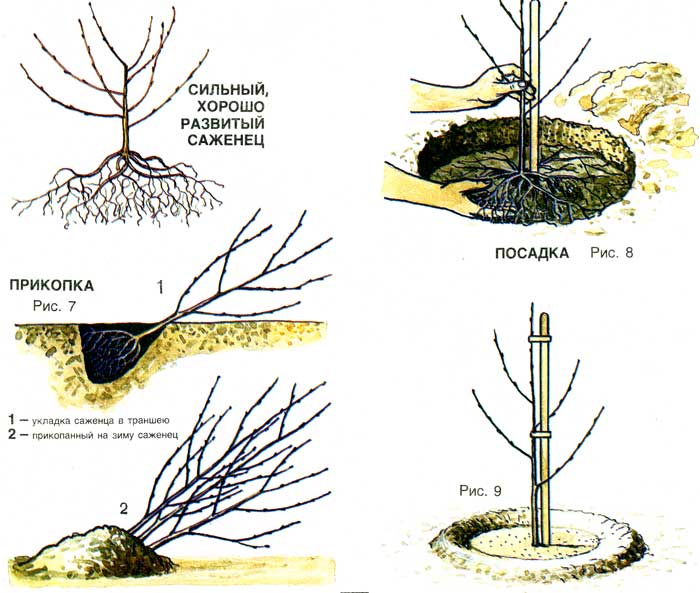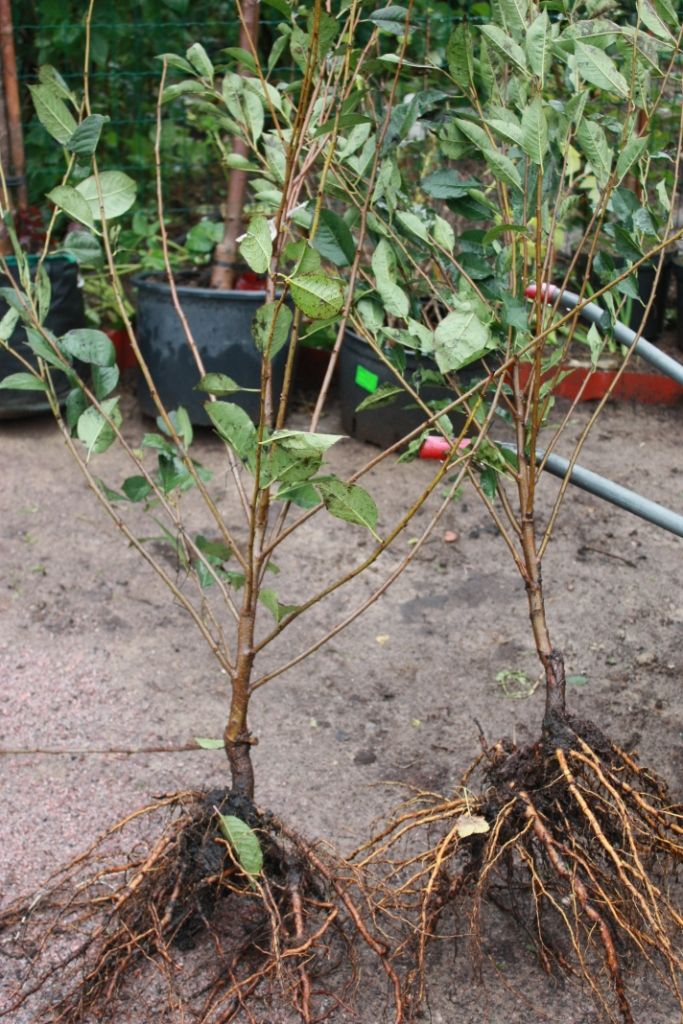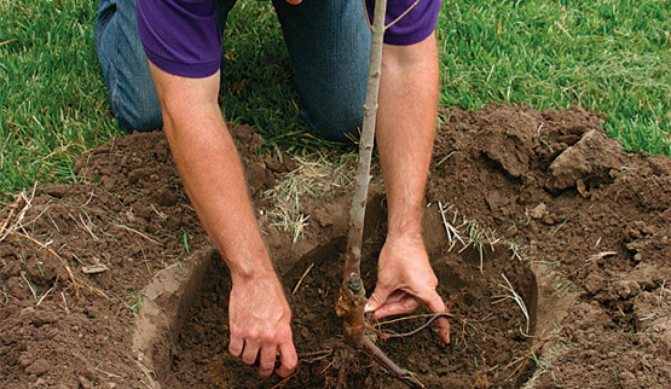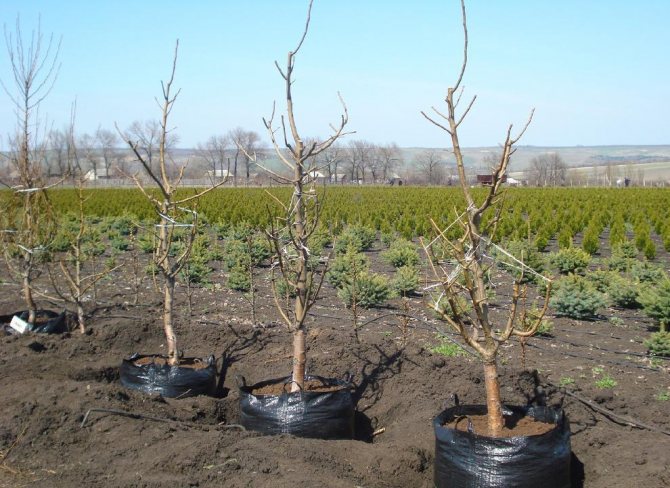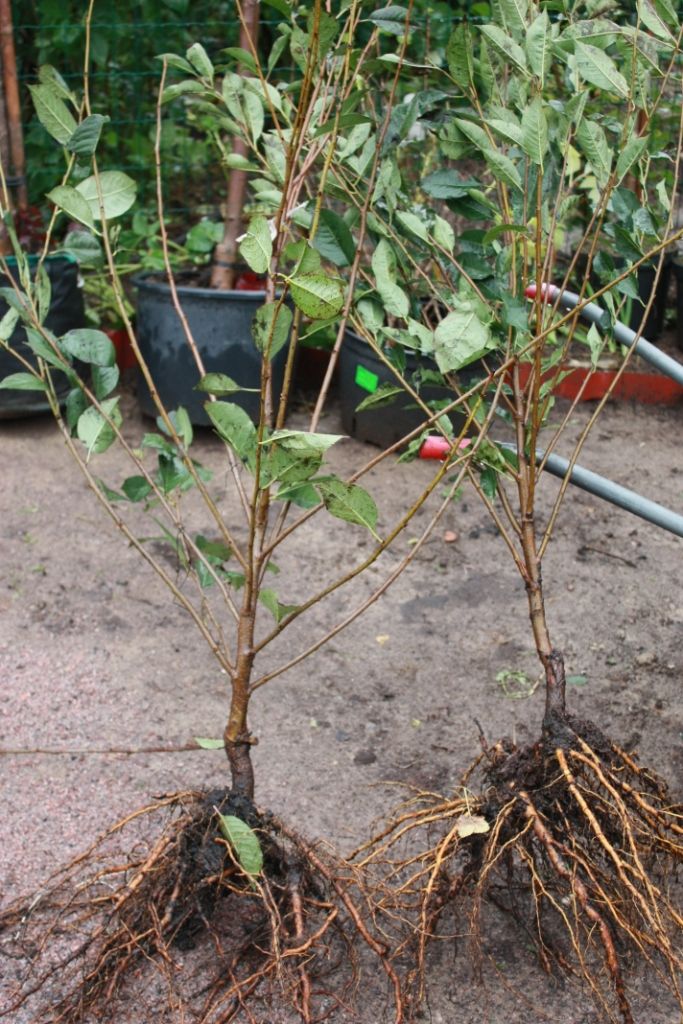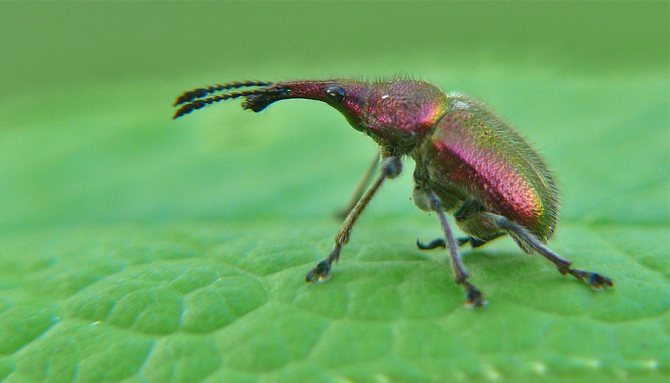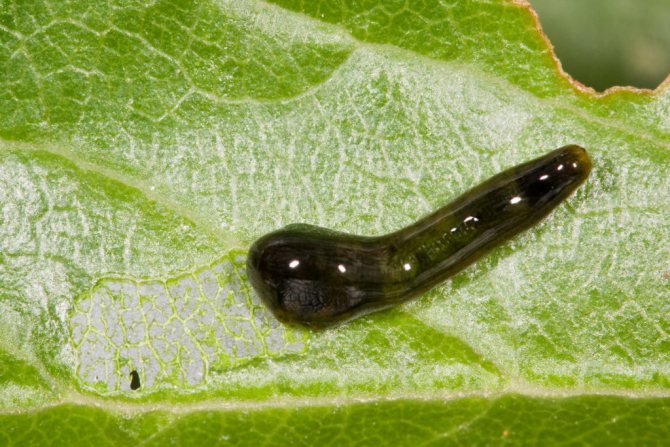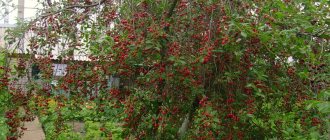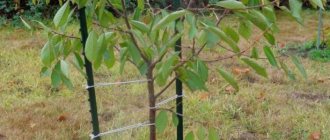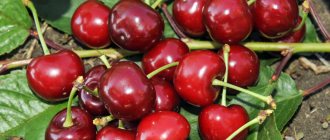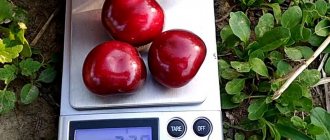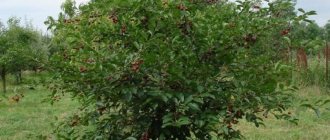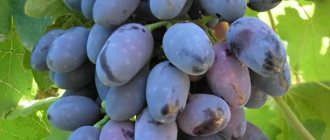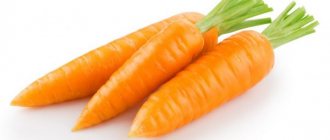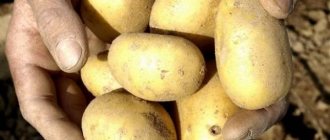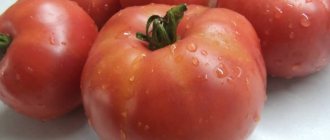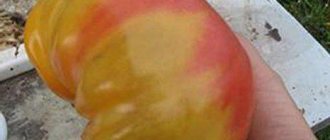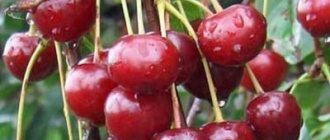Description of cherry varieties "Lyubskaya": photos and reviews
On the site of almost every gardener, you can find several cherry trees, because the fruits of this tree are very tasty. If you love growing cherries or just decided to get such a tree and do not know which variety to choose, then this article will serve you as good advice in your choice.
Cherry "Lyubskaya" is a special kind of cherry, which I will tell you about today. A photo of the variety can also be found below.
Before growing this cherry, you should find out the description of the variety, a little more about its characteristics, planting and care rules. Details on all of this are given below.
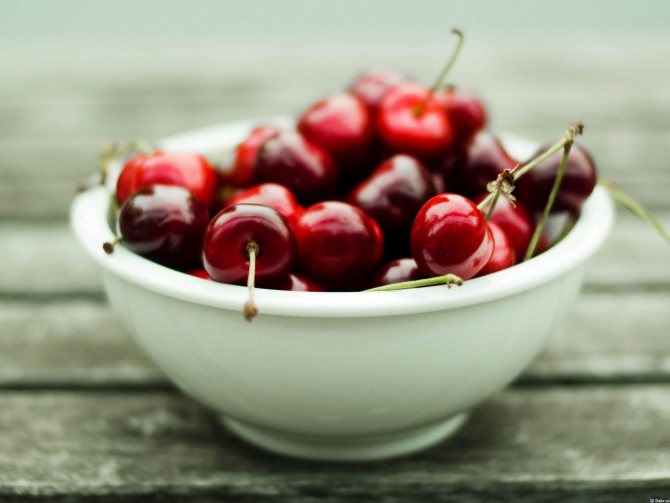
Description and characteristics of the variety
Lyubskaya is a very valuable industrial grade. The frost and winter hardiness of wood is mediocre, so the culture is not grown in the northern latitudes. For its cultivation, good conditions have developed in the central, southern regions of the Russian Federation, where the variety is mainly grown. The Radonezh variety is also planted in the central regions.
Lyubskaya cherry often forms bud mutations that differ in plant habit, productivity, ripening time, quality and size of berries.
Consider the main features of the variety:
- Trees grow relatively small (no more than 2.5 m), have a sparse, spreading crown. The bark of the trunk is brown-gray, cracking, curved branches branch off at an angle of 45 degrees. Annual branches are brown, drooping, contain a ribbed bloom. Vegetative buds have a round-conical shape, slightly deviate from the shoots, degenerative oval. The leaves are slightly shiny, have a dark green tint, dense, serrated at the edges, contain small styloid stipules. The glands are round, small, brown or yellow-brown, located in 1-2 pieces at the base of the leaf. Flowers in an inflorescence 3-4.
- By the nature of fruiting, Lyubskaya - a typical bush-like cherry, fruits are tied mainly on annual branches. They are formed in 1-2, sometimes 3-4, can be medium and large. The shade is dark red, the juice is red. The apex is round, slightly obtuse, with a small funnel, wide. The abdominal part of the fetus is light, has a pronounced suture line. The pulp is juicy and tender, with a pronounced sourness. The stone is medium or large.
General characteristics
This cherry belongs to the very old varieties that were produced in Russia. This variety ripens quite late and has a high yield. Sometimes this cherry is also called more simply: Lyubka. Key characteristics of this cherry that are useful for gardeners to know about:
- Cherry grows low (no more than 3 meters in height). It is characterized by a sparse but very wide crown (round or spreading type).
- The branches of the tree are always curved and form angles of forty-five degrees. They are brownish in shade; they can also have a coating that resembles silver. Important! It is harmless and does not belong to the diseases of the tree; no measures need to be taken to eliminate it.
- Leaves are strong, elongated, deep dark green in color, not too large in size.
- The cherry blossoms actively and during the flowering period, many beautiful flowers of various sizes can be observed on it.Cherry blossoms with inflorescences, on one branch of them there can be up to four pieces at once.
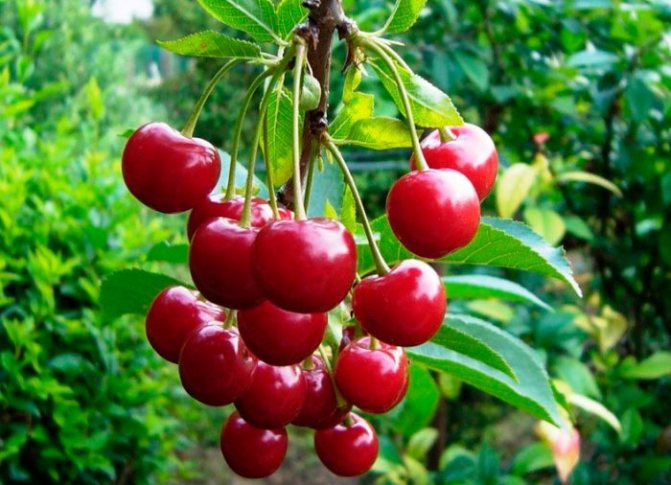

Further care of the Lyubskaya variety
In the first season after planting, young cherries are watered regularly, after the soil dries up, loosening is required. Mature trees require less soil moisture. The number of watering increases only during the flowering period; watering should be stopped 20-21 days before harvesting. If the autumn is dry, it is necessary to carry out water-charging irrigation.
It's important to know!
Before the onset of winter, the trunk circle is mulched with a thick layer of humus (at least 8-10 cm thick); in cold regions, the bushes are covered with burlap, branches of spruce branches, or other covering material is used. Such a shelter will protect trees from rodents.
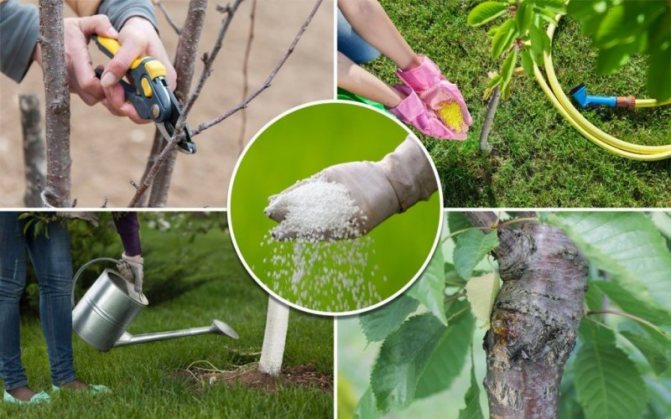

Top dressing
The yield of the Lyubskaya cherry variety directly depends on the quantity and quality of the applied dressings. Experts recommend using a layer of mulch material as fertilizer, for example, mullein, to which wood ash is added. At the same time, a sufficient amount of nitrogen, potassium and phosphorus gets into the soil.
Fertilizing cherries - video
Fruit characteristics
This cherry has a high yield rate. She begins to bear fruit in the second year after disembarkation. There can be a lot of fruits, but the berries themselves are not too large, they can weigh up to five grams at a maximum. Berry shape: round, a little heart-like.
The berries are covered with a very thin but extremely strong burgundy skin. The skin is easily separated from the berry itself, which has a very delicate flesh.
One ovary can contain up to four fruits at a time.
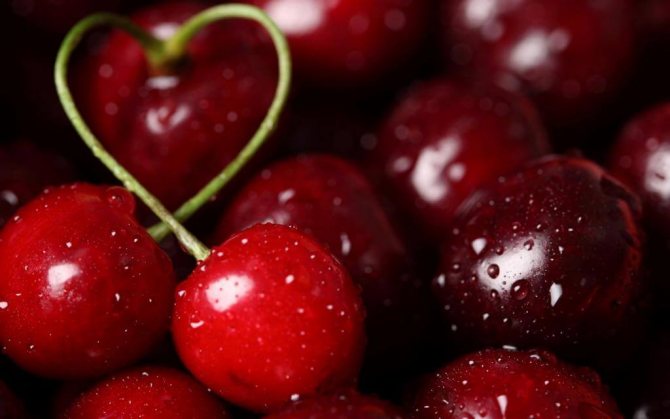

Advantages and disadvantages
Cherry Lyubskaya is one of the best technical varieties, the main advantages of which are:
- high percentage of self-fertility;
- flowering occurs at the end of May, so flowers and ovaries are not damaged by spring frosts;
- by creating appropriate care for these fruit trees, you can achieve high yields from the variety;
- rare crown and miniature size make it easier to care for branches and pick ripe fruits;
- even if the care is not too good, the fruiting of Lyubskoy cherries is still quite high;
- easy to separate the bones from the pulp;
- the harvested crop tolerates transportation over long distances, it is stored for a long time in a cool place;
- fruits easily move away from the stalks, but do not crumble;
- ripe fruits are rather large.


There are few disadvantages of this cherry:
- weak resistance to fungal diseases;
- in regions with a harsh climate, this cherry does not grow without additional shelter;
- the fruit is too sour;
- boles of this variety often suffer from sunburn.
Why grow?
Many gardeners love to grow this particular variety. This is due to the fact that it has a number of such advantages:
- very high yield rate;
- transportability of fruits without any particular difficulties;
- small habit, and therefore this variety can be grown even in intensive gardening.
True, before starting to grow this variety, it is worth knowing the key disadvantages:
- the need to provide protection from cold weather, since the resistance to frost in trees is low;
- a high degree of damage to diseases of the fungal type. Eliminating these diseases can take a decent amount of time;
- small amount of sugar in fruits, sour taste.
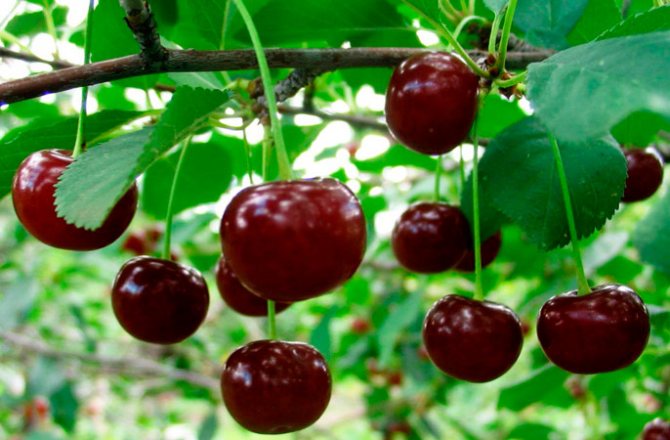

Features of the
The Lyubskaya variety is fruitful, fast-growing, gives beautiful large fruits. It begins to bear fruit 2-3 years after planting. Trees grow maximum yields closer to 8-10 years. Flowering is medium late, the fruits begin to ripen closer to the beginning of August. Flowering lasts from 5 to 8 days, depending on weather conditions. This material will tell you how to grow a cherry from a stone.
For fresh consumption, the fruits of the Lyubskoy cherry are not suitable, but they are ideal for making jam, wine, compotes, drying, freezing.
Winter hardiness
Cherry Lyubskaya has an average resistance to frost. It tolerates average subzero temperatures well, in very harsh winters it grows poorly even with proper shelter. When choosing a planting time (this is autumn, spring, less often summer), one should always take into account the climatic features of a particular area - for example, in frosty winters with low subzero temperatures, it would be better to postpone the procedure to spring so that the seedling takes root, gets stronger and does not die in the winter months. In general, the frost resistance of the culture is good. This article will tell you about the Standard Ural cherry variety.
Disease resistance
The disease resistance of the variety is average, so do not ignore the need for preventive treatments, follow the care requirements. The situation is also aggravated by the negative neighborhood on the site, it can be damaged by fungi, viruses, decay, drying out, cause a deficiency of nutrients. Basic care measures:
- treatment of affected areas chemicals or a mixture of coal and sulfur;
- removal of growths, treatment of wounds on the trunk with pitch;
- burning of fallen fruits and leaves;
- mulching soils of the near-trunk circle of cherries.
In case of fungal infections, treatment with Bordeaux liquid of 1% is recommended, insecticidal preparations are used for insects. Inspect the tree regularly for signs of damage to leaves and branches. Remove damaged areas, treat other parts with antibacterial drugs (for example, Horus, HOM, Topaz).
Pollinators
Cherry Lyubskaya has a high degree of self-fertility. This is an important advantage, since frosts can occur at night in all regions until May, and bees cannot fly due to unfavorable weather conditions. This complicates cross-pollination and leads to lower yields, but not in the case of self-fertile varieties. Lyubskaya forms ovaries and bears fruit in any weather, which allows it to be grown in single-sorted massifs. You can plant varieties with different flowering and fruiting periods in your country house - in this case, the garden will constantly bloom and bear fruit.
Ripening period and yield. Transportability of berries
Lyubskaya ripens in July - in the middle of the month in warm regions and at the end in the northern regions. The fruits can hang on trees for a long time and not crumble. Since the bush is small in size, caring for the crown and harvesting is not difficult. The fruits are large, quite tasty and juicy, have a dark red hue. Their flesh is tender, sweet and sour. Berries are most often consumed fresh, but can also be processed. Transport is well tolerated, send for storage dense, strong fruits without damage. Read about the best varieties for the Moscow region here.
Yield
Fruiting begins in the second year after planting the tree. The yield from the very beginning is quite high, it reaches its peak when the cherry has been growing in the chosen place for eleven years. The flowering period is highly dependent on environmental conditions and can be up to eight days.
Cherry is quite self-fertile, but if pollinating varieties are planted nearby, the effect will be extremely positive and the amount of harvest will increase in the future. As such varieties, Vladimirsky, Anadolsky or Molodezhny can be used.
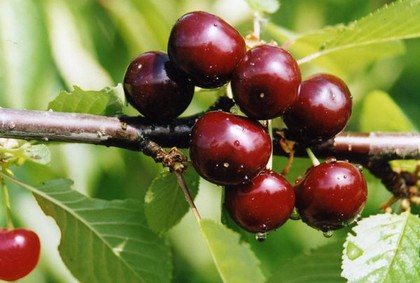

Features of harvesting
Variety Lyubskaya begins to bear fruit for 2-3 years. Productivity depends on the age of the tree and external factors. A five-year-old culture produces 5-6 kg of berries. Subsequently, fruiting increases. The average productivity of Lyubskoy is from 10 to 25 kg per cherry. However, several cases of harvesting 40–50 kg from trees aged from 7 to 16 years were recorded.
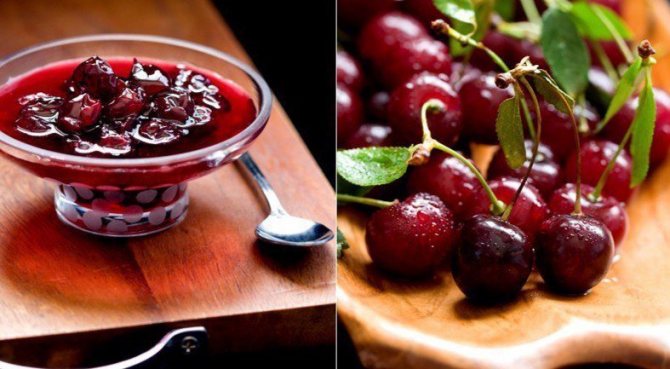

Cherries are used for delicious desserts and preparations
The berries ripen in late July or early August. Ripe fruits do not fall from the tree. Ripening occurs simultaneously. The berries are harvested in the morning; it is recommended to remove them with stalks. Cherries are stored at 0–4 ° C for two weeks. Due to the sour taste, Lyubskoy fruits are rarely consumed fresh. Mostly berries are used to make preserves, jams, compotes, fruit juices, marmalade. They can also be dried and frozen.
Care rules
When growing cherries of this kind, you must remember the following:
- This variety has low resistance to frost, therefore it is necessary to provide conditions that will allow the tree not to die from frost.
- It is necessary to ensure that there is always a sufficient amount of nutrient-type dressings in the soil composition and the tree receives all the required nutrients, otherwise it may begin to wither and become sick.
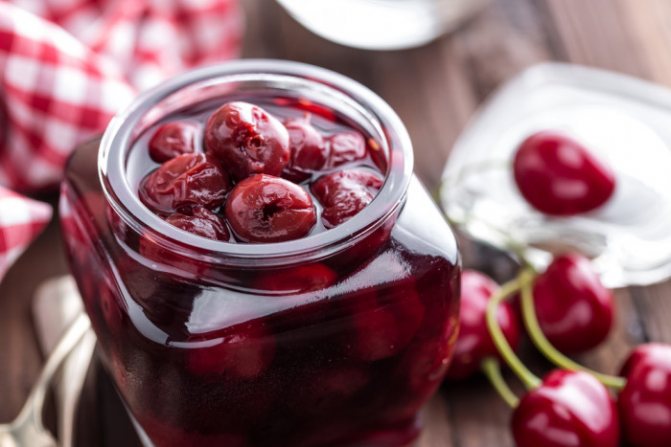

Almost all reviews of this variety are consistently positive. Here is some of them:
- Irina, 27 years old: I am engaged in gardening and growing cherries recently, I mainly need berries for jam. I had a chance to try cherry jam of this variety with a close friend, and after that I realized that I needed to grow such a cherry in my country house. I never regretted it.
- Dasha, 31 years old: a very good variety if you plan to technologically start up berries somewhere, because they are completely unsuitable for direct consumption - that is still sour. It is very easy to grow such a cherry, even despite its low frost resistance, for me it survived for several years even without additional protection from the cold, although the total life of the tree is not very long.
Read also: Derain red - blood-red svidina
Now you know all the key information about this cherry variety. Feel free to grow it in your country house, and you will always have several jars of delicious cherry jam.
Harvesting and processing
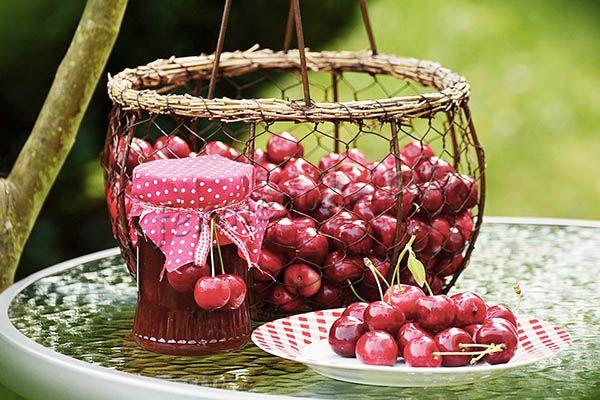

Many gardeners recommend a variety for jam.
Collecting cherries of the Lyubskaya variety is desirable at one time. It is this technique that allows you to protect them from diseases, the appearance of worms or from birds. The beginning of harvesting usually falls in the evening, when the sun is not very active, it is clearly visible, and there is no dew, so the cherry will be dry.
Important!
After picking, cherries no longer ripen, stopping development, so you need to pick them already ripe.
For homemade preparations or fresh consumption (within 24 hours), you can pick cherries without stalks. But, if you need to transport it over long distances or sell it, then it is better to pick berries with stalks - this simple procedure will extend the shelf life.
The collected cherries are put into storage containers. You can separate the seeds and freeze them to feast on delicious berries in winter or use them for baking. Many gardeners recommend the jam variety. In combination with sugar, after boiling, this variety acquires a pleasant taste, delicate, not tart sweetness.
If you need to keep the berries fresh, then at a temperature of -1 ... 0 degrees Celsius and a humidity of 85%, they can lie for 10 days. You can also extend the shelf life by packing cherries in airtight bags.
Cherry Lyubskaya - an old variety with progressive properties
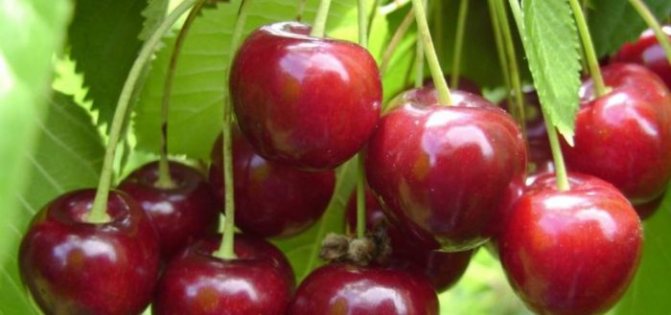

Lyubskaya is the same cherry that will allow you to make many different preparations for the winter, as well as prepare delicious wines, liqueurs and liqueurs. It is a technical grade with many benefits. Among them are absolute self-fertility and high productivity against the background of a compact crown, which forms itself. Like any variety, Lyubskaya is not without drawbacks, it is important to take them into account when growing.
Description of culture
Usually, the Lyubskaya variety is grown as a shrub, although in the State Register the cherry is listed as ordinary, and not steppe.In the northern regions, the tree is shaped by pruning so that it hibernates better. In the south, Lyubskaya cherry can be grown on a trunk.
The variety is a small tree, not exceeding 2.5 m in height. The trunk is covered with grayish-brown bark, covered with cracks. The branches are approximately 45⁰ apart from the trunk and form a rare weeping crown. This can be seen in the photo of the Lyubskaya cherry tree.
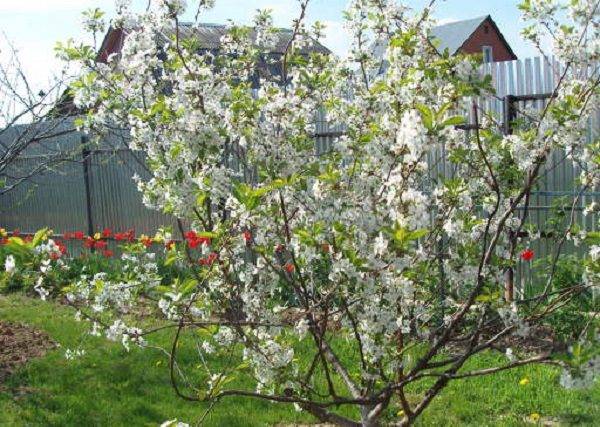

Buds from shoots deviate slightly, oval dark green leaves are pointed at the base and at the end. Flowers of Lyubskaya are collected in 3-4 pieces, white, located on a leg up to 3 cm long.
Fruiting occurs at a later date, mostly on annual branches. Berries of uneven size, medium or large, up to 5 g in weight. Their shape is almost round, with a blunt top. The color of the fruit is dark red; a light strip runs along the clearly visible abdominal suture. Cherry pulp Lyubskaya is red, juicy, with a mediocre sour taste.
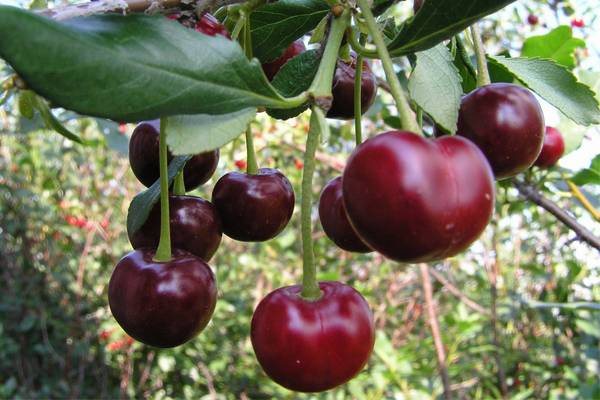

A round seed with a sharp tip separates well, its size in relation to the berry is 6-8%. Green fruits sit firmly on the stalk, as they ripen, the connection weakens, but the cherries do not crumble.
Variety Lyubskaya is recommended by the State Register for cultivation in the following regions:
- Northwest;
- Central;
- Central Black Earth;
- North Caucasian;
- Middle Volga;
- Nizhnevolzhsky.
The history of Lyubskaya cherry
The authorship of this ancient variety is attributed to the entire Russian people. Nobody knows the name of the creator of Lyubskaya. But it was so widespread in the central part of Russia that in 1947 it was accepted for variety testing and entered into the State Register of Breeding Achievements with a detailed description. The preservation of the variety today is ensured by the All-Russian Selection and Technological Institute of Horticulture, located in Moscow.
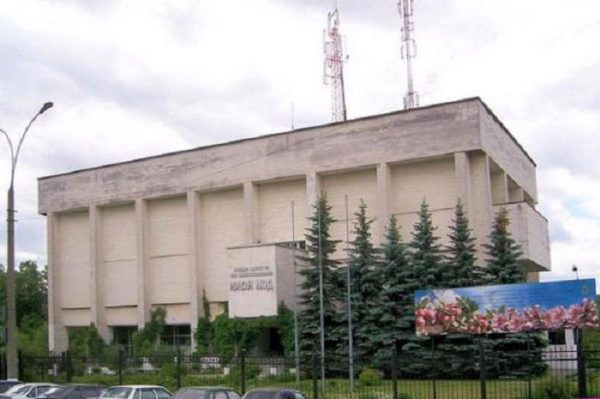

The originator of the variety Lyubskaya is the All-Russian Institute of Horticulture
Lyubskaya is approved for cultivation in the European part of Russia. In the Urals and in the northern regions, this cherry freezes heavily in winter.
Another name of the variety has taken root among the people - Lyubka.
What distinguishes Lyubskaya cherry from other varieties
The exact origin of the Lyubskaya cherry variety, which is widespread in central Russia, is unknown. The first description prepared by N.I. Kichunov, mentions that the culture has long been bred in the Korochansky district (Kursk region).
At the moment, Lyubskaya cherry is included in the State Register for the Central, Northwestern, Central Black Earth, Middle Volga, Lower Volga, North Caucasian regions (zoning since 1947). Read more about the features and benefits of the direction below.
Description of the variety
Lyubskaya grows as a bush up to 2.5–3 meters high. The crown is sparse, spreading, sometimes rounded. Skeletal branches are located to the trunk at the correct angle (45–90 °), there are no sharp branches. Annual shoots often hang down, from this the bush becomes drooping, weeping. The color of the bark is gray-brown.
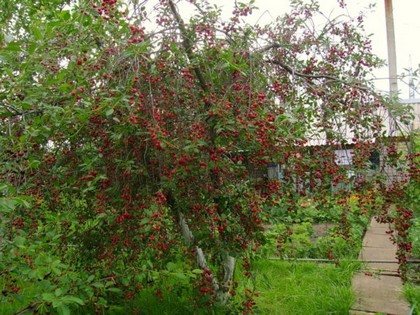

Cherry Lyubskaya grows as a compact, sparse and very productive bush
A wonderful property of this cherry is its early maturity. Planted with a 1-2-year-old seedling, it bears the harvest in the second or third year. At the same time, productivity is growing rapidly. The average yield of a young tree is 10–12 kg, the maximum yield of an 11-year-old tree is 54 kg. Lyubskaya is highly self-fertile. Due to its decorative properties, this cherry is used for landscaping parks and squares, and it gives a full harvest even in single-variety neighborhoods. The variety does not need additional pollination, and itself is a good pollinator.
Cherry Lyubskaya is late, the berries ripen by the end of July - beginning of August. They are large - 4–5 g each, almost round in shape, if you do not notice a small depression at the stalk, thanks to which the cherries look like blunt-pointed hearts. The skin is thin but firm, dark red in color. The pulp is juicy, tender, sweet and sour. The taste is mediocre, so Lyubskaya is widely used for processing: making compotes, jams, marmalades, alcoholic beverages. The berries are dried and frozen.
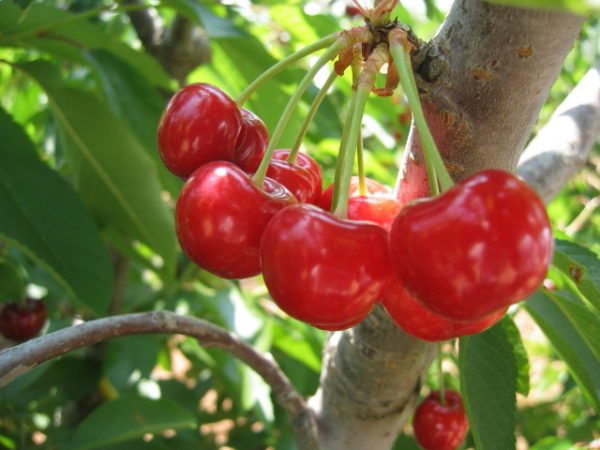

The fruits of Lyubskaya are round, have the shape of blunt-pointed hearts, red
Lyubskaya has many more features. Its berries can be recognized by the well-distinguishable abdominal seam, it has a lighter shade. An easily detachable bone with a sharp tip is hidden inside the pulp. The fruits ripen at the same time and hang on the branches for a long time, do not crumble, but only improve their qualities. The bush practically does not form shoots.
All characteristics in a complex create in the imagination the ideal technical cherry. But there is one very big drawback. This old litter has a weak immunity to the terrible diseases of all stone fruits - moniliosis and coccomycosis. Without multiple spraying with modern fungicides, the crop cannot be obtained. And one more small minus - in severe winters, the crust freezes underneath. But this disadvantage is compensated by the fact that productivity is restored in one season, because Lyubskaya bears fruit on annual growth.
Video: cherries ripen on Lyubskaya
Cherry care activities
Taking proper care of the cherry tree will guarantee a good harvest.
Watering
The variety has a high drought tolerance, which is why frequent and abundant watering is not required.
Table: watering dates
| Calendar dates | Vegetation period | Volumes | Note |
| End of May - beginning of June | End of flowering | 10 l for 1 tree | The necessary fertilizers are applied at the same time |
| August | The period of formation and ripening of berries | ||
| Mid - end of September | End of the harvest season |
Pruning
The procedure is carried out in early spring, before the buds appear. Every year, sanitary pruning is required - damaged and dead branches are removed.
Taking into account the peculiarities of the formation of a tree of the Lyubskaya variety, in the first pruning, it is necessary to leave about 10 large shoots. During the event, you need to control the uniformity of the placement of branches in the future crown. Slices must be processed with garden pitch.
In the second year, molding pruning is carried out. All branches growing inside the crown are removed, and young shoots are shortened by 0.5 m. Annual growths from trees cannot be removed.
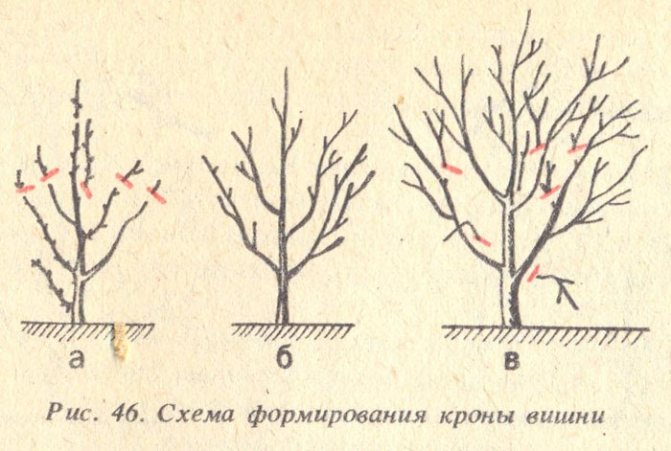

Pruning a fruit tree is an annual event that allows you to get an unseen bush
Experts recommend to deal with semi-skeletal branches one year, and skeletal branches the next.
Preparing for the cold
Preparation of cherries for wintering begins at the end of the harvest. It is necessary to remove damaged and infected branches from the crown, dig up the trunk circle with fertilizers, spill and mulch with organic materials (crushed tree bark, wood chips or straw).
In harsh winters, you can additionally cover the tree itself. The lower tier of branches is bent to the litter. The shoots fixed in this position are covered with dry straw. The trunk must be whitewashed and wrapped in paper or burlap.
Top dressing and fertilization
If during the planting of a young tree all the necessary elements were introduced into the soil, then the next top dressing is carried out after 2 or 3 years.
| Period | Year | Method of application | |||
| Root dressing | Note | Foliar dressing | Note | ||
| Early spring | 2nd | Embedding of ammonium nitrate or urea in the soil - 0.05–0.07 kg per 1 tree |
| Urea 0.02 g per 10 l of water |
|
| 3rd | Adding 0.02 kg of urea or 0.03 kg of ammonium nitrate per 10 liters of water (5 liters of solution per tree) | ||||
| 4th | Embedding in the ground during the digging of urea 0.15-0.2 kg per 1 tree | ||||
| 5th and 6th | Top dressing with ammophos 0.03 kg per 10 liters of water | ||||
| 7th | When digging, 0.3 kg of urea per 1 tree is embedded in the soil of the near-trunk circle of urea | ||||
| After flowering | Immediately | For 5–6 buckets of water: 1 bucket of manure, 1–1.5 kg of wood ash. Insist for 3-6 days. For one tree: half a bucket of mixture + 2-3 buckets of water | Ideal preparation 4-5 ml / l (spraying on leaves) | ||
| In 2 weeks | |||||
| After harvest | Annually | Adding superphosphate and sulfate to the soil in 2 tbsp. l. 10 liters of water. Per tree: 35-40 l | |||
| 4th | When digging the soil, the incorporation of double superphosphate 0.3-0.35 kg per 1 tree and potassium sulfide 0.1-0.12 kg per 1 tree | ||||
| 7th | Digging up the soil with double superphosphate 0.4-0.5 kg per tree, potassium sulfide 0.15-0.2 kg, adding humus or compost 40-50 kg | ||||
Growing features
Due to its compact crown, Lyubskaya is suitable for intensive gardening. The variety is a godsend for owners of small plots who, despite such a problem, want to collect rich harvests of cherries. The seedling can be placed, retreating only 2–2.5 meters from buildings, fences, bushes and trees. Cherries will grow and bear fruit brilliantly solo, with no additional pollinating bushes in the neighborhood.
About pruning a bush
When growing Lyubskaya, you do not have to worry about the formation of the crown and spend a lot of time and effort on uprooting the overgrowth. This is a typical bush cherry, can be grown in 2-3 stems and only sanitary pruning is done annually. The activity consists in removing broken and dry branches.
Read also: Honeysuckle Blue Bird: variety description, photos, reviews
I have a different variety of cherries, but for many years of growing this crop, I was convinced that it is the most problem-free in formation, if you know one little secret. At first, I tried to form cherry bushes and trees according to recommendations from the Internet: after leaf fall or before budding, I chose correctly and beautifully located skeletal branches, cut off growths that were too long, in my opinion, cut out the overlapping branches growing inside the crown and hanging down branches. The result was disastrous: what remained of the tree in the spring turned out to be half unviable. Most of the branches did not want to be covered with leaves.
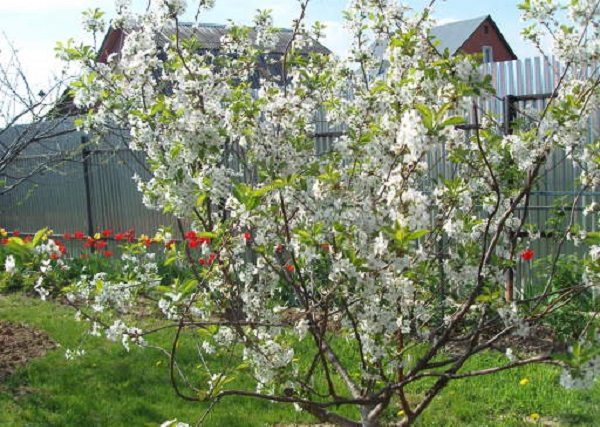

Cherry Lyubskaya in bloom, below you can see dry bare branches that should be cut
One video blogger helped to understand what the problem was. He voiced a valuable thought for me: on cherries, due to the fact that they often get sick, freeze, there are always a lot of dry branches. Thinning and shaping often boils down to simply deleting those branches. And an inexperienced gardener can understand which of them are alive and which have dried up, only in the spring by the awakening buds. It turns out that I cut the good branches and left them dry. Now I always look forward to spring and the appearance of sticky leaves, and only then I approach my cherries with a pruner.
How to protect Lyubskaya from disease
To protect against fungal diseases, many fungicides are produced today: Bordeaux mixture, HOM, Speed. Judging by the reviews, the most popular and effective is Horus. It can be processed throughout the growing season, except for the phases of flowering and ripening of fruits. Spray for the first time when signs of illness appear, carry out subsequent treatments at intervals of 14 days until complete recovery. The last treatment is done no later than 15 days before harvest.
However, it is not necessary to wait for the arrival of diseases; it is better to do preventive spraying on the green cone and again after 10-14 days. For the entire season, the disease-resistant cherry will have to be processed at least twice in the spring and the same amount after harvest.
Video: cherry coccomycosis, how to deal with bush baldness
My cherries this year were very sick with coccomycosis. In the spring, I treated them twice with the fungicides Skor and HOM. Despite this, in the midst of the ripening of the berries, the leaves began to turn yellow and crumble.It is no longer possible to spray, then I, out of a desire to somehow help my cherries, weeded out the weeds under them to the bare ground, cut out the lower branches and shoots so that the bushes were well ventilated from below. Collected yellow leaves and diseased berries. During these procedures, I discovered gum flow on two trunks.


Gum appears in the places of cuts or cracks in the bark
She treated gum treatment using a technology that combines scientific and popular advice: she removed the resin, cleaned it to healthy wood with a teaspoon, and washed it with a solution of copper sulfate. And then she began to conjure: several times a day she approached the diseased trunks and rubbed the wounds with the leaves of sorrel, then coltsfoot, then plantain. After 2-3 days, the gum stopped flowing, the wounds healed, and the most amazing thing is that the leaves stopped turning yellow and crumbled. Although they were almost all covered with spots of coccomycosis, they remained green and did not dry out anymore.
Gum therapy is another problem that the owners of Lyubskaya may face. Its bark is prone to cracking even in the summer, not to mention the chills in the winter. To prevent the dire consequences of wounds on the trunks, carefully and regularly inspect your cherries and provide timely assistance. And to protect against frost damage, whiten trunks and skeletal branches in autumn to a height that your hand can reach. White color will repel the sun's rays, which will prevent sharp jumps between temperatures during the day in the sun and at night, the wood will not "play", which means it will not crack.
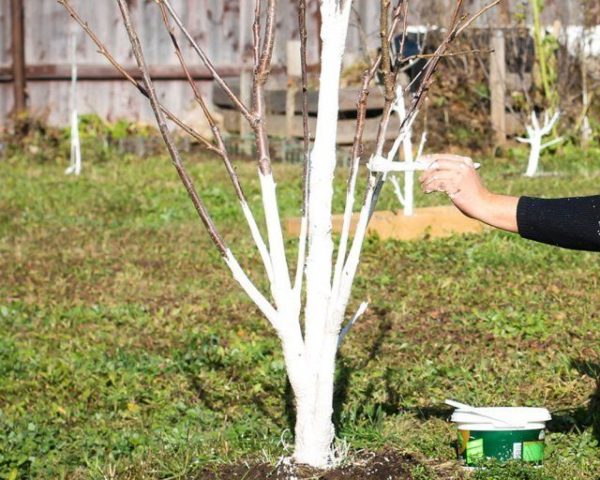

Whitewashing of cherries is the prevention of frost cracks and gum disease
Rest care
Like any other cherry, Lyubskaya needs:
- watering, especially during flowering and growth of ovaries, spend 30 liters per 1 m²;
- top dressing, apply them annually: in the spring nitrogen, during flowering - complex with trace elements, in the fall - phosphorus-potassium;
- caring for the trunk circle, keep it free of weeds and loose, mulch will help with this.
Planting and leaving
Usually in nurseries you can buy seedlings at the age of one year. Youngsters are planted in early spring in an open area, which is illuminated by the sun all day.
It is necessary that at the landing site prevail sandy, sandy loam or loamy soil.
It is also important that in this place groundwater does not come close to the surface of the earth, which can harm the root system.
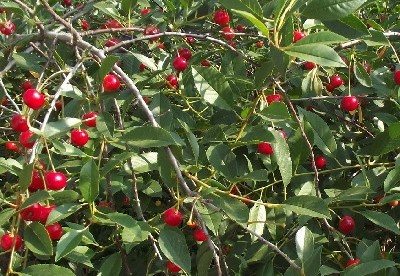

During the rooting of the seedling, it is necessary to cut off the top. After the initial pruning, there should be no more than half a meter of stem.
Such a formation will give an impetus to the growth of the tree not upward, but in width.
This crown configuration is useful for a variety of reasons, including being very suitable for quick and easy harvesting.
Usually, for planting a cherry seedling, they dig out a hole with a diameter of 50-60 cm and a depth of 40-60 cm.
The earth extracted during digging is mixed with organic and mineral fertilizers. The resulting mixture is then used to drop in the roots of the tree.
After the seedling is set in the hole, and its root is covered with earth, the area around the trunk of the planted individual with a radius of 30-40 cm is carefully tamped with feet or improvised means.
Pick-up location watered with 2-3 buckets of settled water... A plot of slightly sagging earth is mulched with sawdust and humus, the layer of which should be 2-3 cm.
It should be noted that the variety Lyubskaya very picky about the quality of the soil. All subsequent years of the tree's life he should be provided with adequate food.
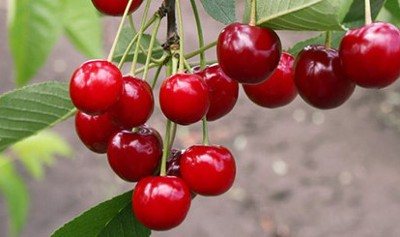

This variety reacts especially well to mineral dressing in the spring. Regular watering of the tree is required.
It is also necessary to constantly monitor the condition of its crown. Despite the fact that the crown of Lyubskaya is most often quite rare, the dominance of dry and too long branches should not be allowed.
Reviews of gardeners about cherry varieties Lyubskaya
The most painful old varieties of folk selection: Vladimirovskaya, Lyubskaya, Shubinka, etc. You don't need to buy and plant them.
Read also: Plum Zarechnaya early: descriptions of the variety with photos, reviews, planting and care
Chamomile13
I planted Lyubskaya, Vladimirskaya was, and also Kharitonovskaya .. they winter well, Lyubskaya and Kharitonovskaya ideally form the crown, I help only by breaking down into tiers, an excellent angle of branching .. on the 3rd ood everything is in flowers !! The taste is good.
Helen
Many summer residents probably know Lyubskaya. This variety is quite common in the Moscow region. Ripening of berries occurs in the middle of summer. The variety is fruitful, the berries are large, dark. But winter hardiness is average, so trees may freeze slightly.
vetrov53
The Lyubskaya cherry has so many advantages that they overshadow some rather serious disadvantages. Crown care is minimized, there are practically no overgrowths, pollinators are not needed. The tree is small but very productive. However, you can easily be left without a crop if you do not pay attention to just one agricultural technique - protection from diseases.
Landing features
For planting, you should purchase annual plants with several branches. There should be no painful areas on the stem and roots.
When choosing a place for planting, remember that cherries prefer loamy and sandy loamy soils with a neutral reaction (high acidity is especially undesirable). A high level of groundwater negatively affects the plant.
You can plant cherries in spring and autumn. Site preparation in both cases is the same. Planting times may vary for each region. The best period can be considered from the end of March to the beginning of April, and in the fall - from September to the beginning of October.
Step-by-step instruction:
- Prepare the landing pit. This must be taken care of in advance. For spring planting, it is advisable to prepare it in the fall, for autumn planting - a couple of weeks before the start of work. Compare the diameter of the hole with the size of the root system of the seedling, and the depth is about 0.5-0.7 m.
- Immediately before planting, 2 buckets of organic matter (humus, compost, etc.) should be poured into the pit. If the soil is too clayey, you can add 0.5 buckets of sand. Every gardener knows the soil in his area, if you think it is poor, it will not hurt to add a little mineral fertilizers - 0.2–0.3 kg of superphosphate and 0.1–0.2 kg of potassium sulfate (it is undesirable to add nitrogen fertilizers).
- Drive in a peg at the edge of the hole. It should be about 1.5m tall.
- Place a seedling in the center of the hole, straighten the roots and sprinkle with earth.
- Having covered it in half, with your palm or foot, slightly compact the soil around the plant. In this case, you need to ensure that the vaccination site is 5-10 cm above ground level.
- Pour a bucket of water into the hole and, after waiting until it is absorbed, add to the required level.
- At the end of the work, pour another bucket of water.
Video: planting cherries
If you plant more than one tree, then leave a distance of about 3 m between plants. In the future, this will make it possible to move freely between plantings, and at the same time, cherries will not oppress each other.
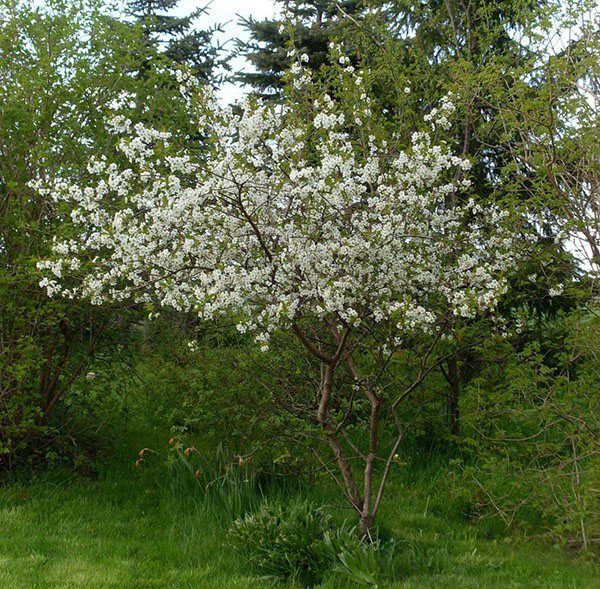

Lyubskaya does not need pollinators
When planting Lyubskaya cherry in your garden, you should not worry too much about pollinating plants - this variety does not need third-party pollination, although if they are available, the yield can increase by 10-15 percent. Among the best pollinators, we will single out the varieties Vladimirskaya and Shpanka.
Main characteristics of Lyubskaya cherry
This variety is the result of the so-called "folk selection": it is not known for certain who its author is, where and when the cherry was bred. It is believed that at one time not one amateur gardener worked on improving the qualities of Lyubskaya, but a whole group of such enthusiasts. But history has not preserved their names. The few remaining information indicates that the place of origin of the variety is roughly the Kursk province, from where it spread throughout the territory of central Russia. In the 90s of the XIX century.NI Kichunov, Doctor of Agricultural Sciences, drew attention to the beautiful and fruitful cherry. He became the author of the first scientific description of the variety. Later, Lyubskaya underwent breeding research. As a result, in 1947, it entered the varietal register of the Soviet Union and was zoned in many regions.
Attention! There is evidence that the composition of the berries of the Lyubskaya variety grown in different regions of Russia is not the same. Depending on the region, the indicators of the content of sugar, free acids, and also ascorbic acid differ.
Lyubskaya is one of the representatives of the common cherry species; it has both common characteristics characteristic of hybrids of this class and individual characteristics. In general, the main characteristics are as follows:
16 excellent varieties of plums for the Moscow region
- The height of the tree is up to 2.5-3 m, it belongs to the bushy varieties.
- The root system has horizontal and vertical branches. Some occupy an area that is 1.5 times the projection of the crown, others lie at a depth of up to 2 m.The main roots are concentrated at the level of 0.4 m.
- The bark is gray-brown in color, with many holes for gas exchange.
- The crown is spherical, not very dense. One of the differences of the variety is the drooping annual branches of brown color with a silvery bloom.
- The leaves are dense, dark green, with yellowish veins, oval, narrowed in shape, with pointed ends and a lot of serrations.
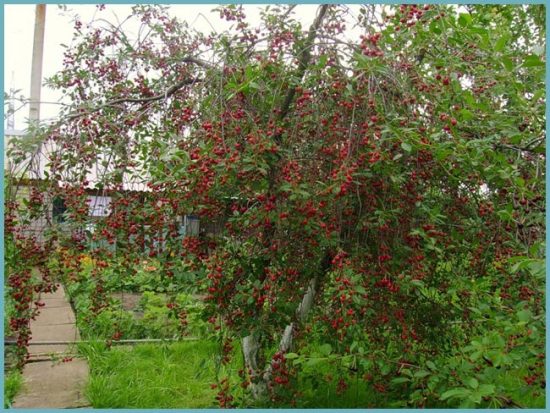

Diseases of cherries and the fight against them
One of the weaknesses of the Lyubskaya variety is its low resistance to fungal diseases. Most often, trees suffer from coccomycosis and moniliosis.
Coccomycosis
One of the most dangerous and insidious diseases of stone fruits. The development of the disease is facilitated by strong moisture and high temperature (above 20 degrees). In such an environment, fungal spores multiply at lightning speed. The disease manifests itself on the leaves. They become covered with brownish and red spots, which grow, drying up the leaf plate. The lower part of the leaf takes on a pink bloom. Starting to actively infect leaves at the beginning of summer, in the second half of it, the foliage will already be completely destroyed, and the branches will remain bare. Losing leaves early, trees remain unprepared for winter, as a result, they do not survive it well and by spring they lose most of the shoots. With the arrival of heat, pathogens are reactivated and continue to kill the plant.
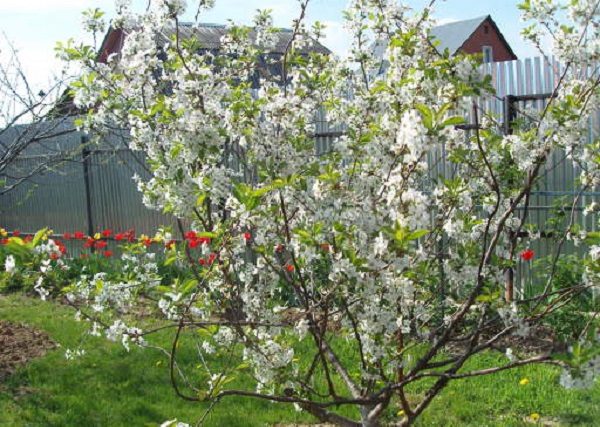

As a result, almost immediately the yield of cherries decreases, the fruits become small, rotten and tasteless. If the gardener noticed that the leaves begin to fall off in the middle of summer, then most likely the tree is affected by coccomycosis. Fallen leaves are collected and burned off-site. Plants are treated with Bordeaux liquid and other fungicides. Spraying with chemistry is carried out in several stages, not forgetting that during the growing season it is unacceptable to use poisons dangerous to humans, otherwise the fruits will be affected.
Moniliosis
A common disease among all fruit trees. Crops are affected mainly in spring during flowering. The fungus gets into the tree through the flower and causes the wood to dry out. Initially, the affected areas look as if frozen in the cold. The bark is covered with gray rough spots. The sap leaves the branches and they dry out. The fruits are also affected - they dry out and mummify.
note: the disease appears in a humid environment, with irregular pruning and poor care.
As soon as it became clear that we were dealing with moniliosis, they immediately remove all fallen and affected foliage, clean the top layer of the soil. Sore areas of the bark are cut out, cuts are made, removing part of the healthy wood. All fruits, including healthy ones, are removed from the tree and destroyed. Since the disease is activated in the spring, it is already in early spring that it is necessary to treat the plantings with Bordeaux liquid or other fungicides. Re-spraying is carried out at the end of flowering.Such drugs as Horus, Mikosan-V, Skor are effective.
Clasterosporium disease
Another name is perforated spotting. The fungus infects all parts of the plant in any flock of the growing season, even flowers. First, brown spots appear on the foliage, which over time, as it were, burn huge holes in the leaves. Leaves fall. Getting on the fruits, the fungus dries them out, and they fall off before they ripen.
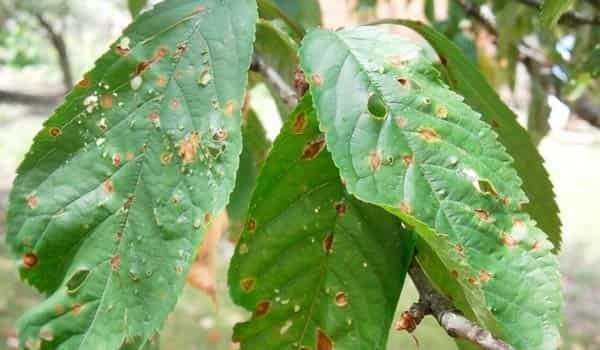

The development of the disease requires urgent intervention, otherwise you can lose the garden in one summer. Complex fungicides are used to treat trees. Spray both affected areas and healthy ones. The cure of the disease is divided into several stages, which are carried out up to the beginning of the formation of the fruits.
Numerous insects are engaged in the pest of cherries, the most dangerous of which are aphids and gnawing parasites. Often on the shoots you can find cherry slimy sawfly, cherry shoot moth, cherry weevil. By their actions, they infect all parts of the plant, lay larvae on the leaves and in the bark, which hibernate right in the tree and in the spring, with the appearance of heat, continue to destroy the tree. In the fight against them, folk remedies are used, for example, ash and soap solution. If the population has grown strongly, then "heavy artillery" - insecticides (Fufanon, Aktellik, Karbofos) are used.
Reviews of summer residents about the pros and cons of the variety
The owners of summer cottages note the following advantages of Lyubskaya cherry:
- self-fertility - the tree pollinates itself, therefore it does not depend on the activity of bees and other insects, and can also grow alone;
- the optimal period of flowering and fruit setting - occurs when even recurrent frosts are already behind, which means that the harvest is out of danger;
- rapid ripening of berries and stable productivity of the culture - in the middle zone, 25 kg of fruits can be harvested from one cherry, in the south of Russia - and 35 kg each;
- compactness of the tree - this greatly facilitates pruning and harvesting;
- good transportability - convenient for those who grow the variety for commercial purposes.
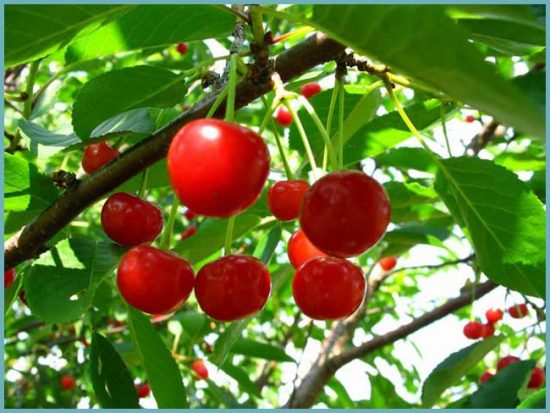

- sour taste, which is not to everyone's liking;
- susceptibility to fungal diseases;
- short life cycle: in central Russia, a tree lives and bears fruit for up to 15-17 years, in the south - up to 25 years;
- poor winter hardiness - in the northern regions, Lyubskaya does not take root;
- tendency to freezing and sunburn.
For all the disadvantages, the Lyubskaya variety has not lost its popularity among summer residents for many years. Its cultivation does not require large costs and is considered economically viable. In suitable conditions and with proper care, cherries give a stable harvest for many years.
Diseases and pests
One of the disadvantages of Lyubskaya cherry is susceptibility to moniliosis and coccomycosis, and insect pests can also attack the cherry tree.
Table: cherry pests
| View | Harmfulness | Processing period | A drug | Prevention methods |
| Cherry weevil (cherry elephant) Crimson beetle with golden tint, reaching a length of 5–9 mm. | Damages kidneys, ovaries and fruits themselves. With a mass settlement, it is capable of destroying the entire crop. | In two steps: immediately after flowering and a week after it. |
|
|
| Cherry fly Insect of dark (brown or black) color, reaching a length of 5–9 mm. | The larvae of the pest develop inside the fruit, feeding on their pulp. In this case, damaged berries darken, deform, rot and fall off. |
| Arrivo, Fury, Confidor, Actellic. |
|
Photo gallery: what cherry pests look like
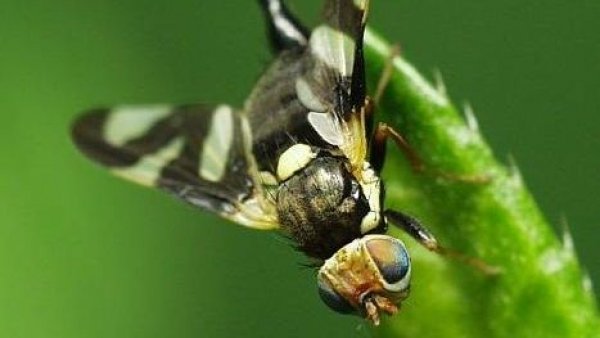

An adult cherry fly reaches 5-9 mm
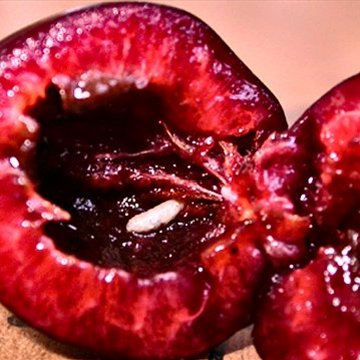

The cherry fly larva damages the fruit from the inside
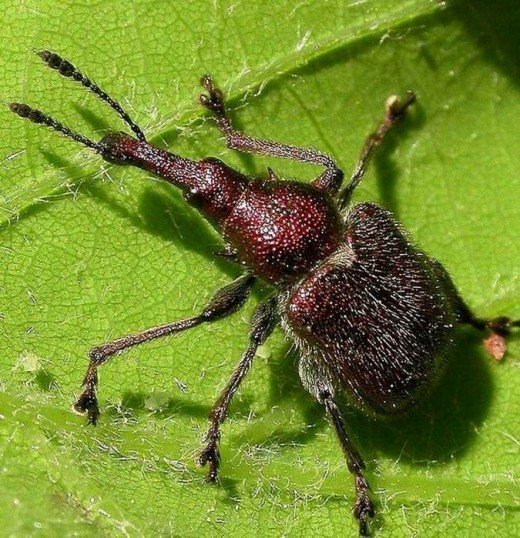

With mass colonization, the cherry weevil is capable of destroying the entire crop.
Table: Disease Control
| Name | Harmfulness | Processing period | A drug | Prevention methods |
| Coccomycosis | Fungal disease affecting the leaves. It manifests itself as reddish-brown dots growing along the plane of the sheet. Fungal spores form on the back of the leaves in the form of a pinkish bloom. Cherries affected by the disease are deformed. A weakened tree can freeze in cold weather. | Early spring | Processing with Bordeaux liquid 3-5%; processing with Nitrafen. |
|
| Before and after flowering | Spraying with Bordeaux liquid 1%. | |||
| After harvest | Spraying with copper oxychloride 0.4%. | |||
| Moniliosis | A disease affecting branches and leaves. It shows up as a gray coating. Old branches crack, releasing gum. Moniliosis also appears on drupes in the form of rot. The berries dry up, do not fall off. | Early spring | Spraying with Bordeaux liquid 3%; iron sulfate 3%. | Removal and burning of affected branches and carrion. |
| After the end of flowering | Spraying with Bordeaux liquid 1%; treatment with Ftalan, Kuprozan, Tsineb, Kaptan. |
Photo gallery: cherry diseases
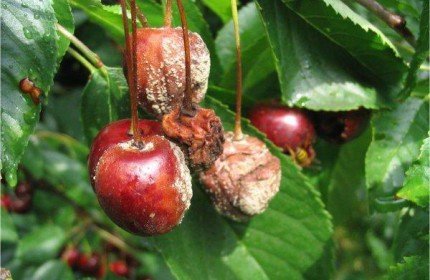

Fruits affected by coccomycosis are deformed
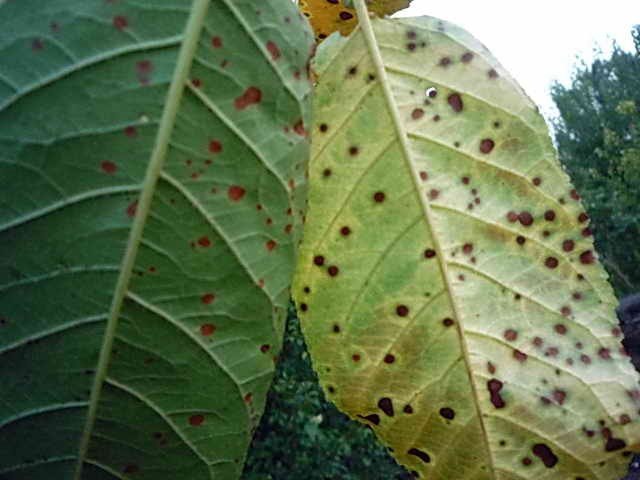

Brown dots on the leaves are a sign of coccomycosis
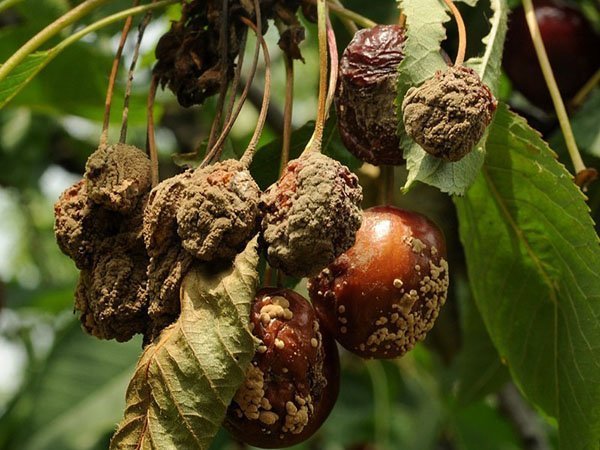

With moniliosis, the berries dry out, but do not fall
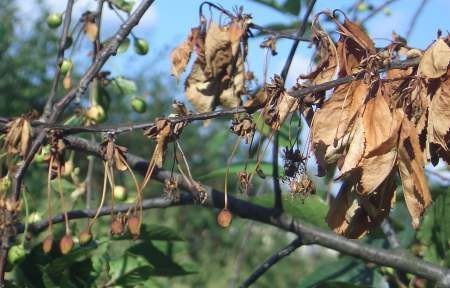

A plant affected by moniliosis looks burnt.
Agrotechnics
The tree is propagated by planting seeds or growing from a seedling. Naturally, trees are most often propagated in the second way.
The tree loves the sun, but does not like drafts. Therefore, it is best to choose the southern side of the site for planting. In addition, special attention should be paid to the quality of the soil. Lyubskaya prefers loamy or sandy loamy soils. The acidity of the soil should not exceed 7. If the soil is too acidic, lime it before planting.
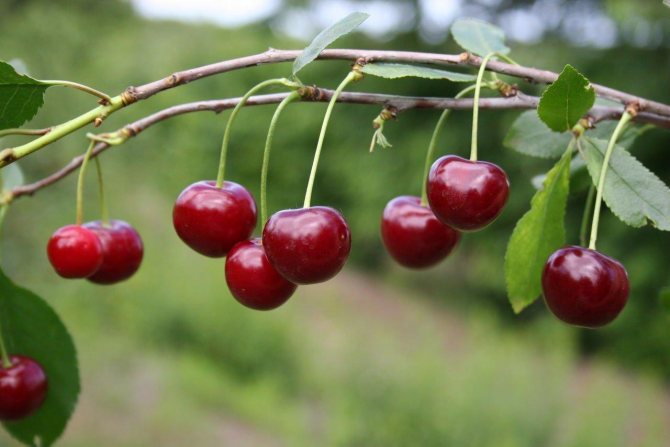

Water the tree at least three times a year. The first time this is done before flowering. The second - during the formation of ovaries. And the last time the cherry is watered during the ripening period. Use at least 20 liters of water each time you water.
Prune the tree twice, in spring and fall. This removes overgrown and dried branches.
Mineral fertilizers are used as top dressing. They are introduced either under the root, or they are sprayed with the crown. It is recommended to use nitrogen-containing substances in early spring.

